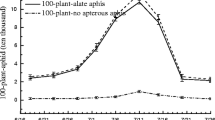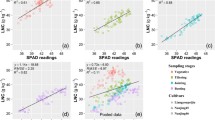Abstract
Reflectance and SPAD readings were measured in rice grown under different nitrogen fertilizer rates and infested with different numbers of brown planthopper (BPH), Nilaparvata lugens, to assess the relationships among these variables. The results showed that SPAD readings and reflectance from rice were significantly affected by BPH infestations and nitrogen fertilizer rates, whereas there was no interaction between the two factors. SPAD readings and reflectance decreased as BPH infestations increased but they increased as nitrogen fertilizer rates were increased. SPAD readings varied with position of leaf on the same stem of rice. The fourth and fifth leaves were more sensitive to BPH infestations than the first and second regardless of application rates of urea. The ratio indices of SPAD readings of the fourth to first leaf (RSPAD4/1), and fourth to second leaf (RSPAD4/2) were significantly related to BPH infestations, and they were relatively independent of nitrogen fertilizer rates in the single stem rice. The spectral reflectance from rice canopy significantly decreased in the near-infrared wavelength range as BPH infestations increased. The modified chlorophyll absorption ratio index (MCARI710) was found more suitable to relate the numbers of BPH under different nitrogen fertilizer rates and durations of BPH infestation. The main effects of BPH infestations on SPAD reading and reflectance indices were consistent regardless of nitrogen application rates. Therefore, SPAD reading and spectral indices have potential to detect BPH infestations in rice fields.






Similar content being viewed by others
References
Abdel-Rahman, E. M., Ahmed, F. B., van den Berg, M., & Way, M. J. (2010). Potential of spectroscopic data sets for sugarcane thrips (Fulmekiola serrata Kobus) damage detection. International Journal of Remote Sensing, 31, 4199–4216.
Bottrell, D. G., & Schoenly, K. G. (2011). Resurrecting the ghost of green revolutions past: The brown planthopper as a recurring threat to high yielding rice production in tropical Asia. Journal of Asia-Pacific Entomology, 15, 122–140.
Capucho, A. S., Zambolim, L., Duarte, H. S. S., Parreira, D. F., Ferreira, P. A., Lanza, F. E., et al. (2010). Influence of leaf position that correspond to whole plant severity and diagrammatic scale for white spot of corn. Crop Protection, 29, 1015–1020.
Carter, G. A., & Miller, R. L. (1994). Early detection of plant stress by digital imaging within narrow stress-sensitive wavebands. Remote Sensing of Environment, 50, 295–302.
Cheng, J. A., & Zhu, Z. R. (2006). Analysis on the key factors causing the outbreak of brown planthopper in Yangtze Area. Plant Protection, 32, 1–4.
Daughtry, C. S. T., Walthall, C. L., Kim, M. S., de Brown Colstoun, E., & McMurtrey, J. E. (2000). Estimating corn leaf chlorophyll concentration from leaf and canopy reflectance. Remote Sensing of Environment, 74, 229–239.
Delalieux, S., Somers, B., Verstraeten, W. W., Van Aardt, J. A. N., Keulemans, W., & Coppin, P. (2009). Hyperspectral indices to diagnose leaf biotic stress of apple plants, considering leaf phenology. International Journal of Remote Sensing, 30, 1887–1912.
Deol, G. S., Reese, J. C., & Gill, B. S. (1997). A rapid, nondestructive technique for assessing chlorophyll loss from greenbug (Homoptera: Aphididae) feeding damage on sorghum leaves. Journal of the Kansas Entomological Society, 70, 305–312.
Elliott, N., Mirik, M., Yang, Z. M., Dvorak, T., Rao, M., Michels, J., et al. (2009). Airborne multi-spectral remote sensing of Russian wheat aphid injury to wheat. Southwestern Entomologist, 32, 213–219.
Esfahani, M., Abbasi, H., Rabiei, B., & Kavousi, M. (2008). Improvement of nitrogen management in rice paddy fields using chlorophyll meter (SPAD). Paddy and Water Environment, 6, 181–188.
Franzen, L. D., Gutsche, R. A., Heng-Moss, M. T., Higley, G. L., & Macedo, B. T. (2008). Physiological responses of wheat and barley to Russian wheat aphid, Diuraphis noxia (Mordvilko) and bird cherry-oat aphid, Rhopalosiphum padi (L.) (Hemiptera: Aphididae). Arthropod Plant Interactions, 2, 227–235.
Fraulo, A. B., Cohen, M., & Liburd, O. E. (2009). Visible/near infrared reflectance (VNIR) spectroscopy for detecting two spotted spider mite (Acari: Tetranychidae) damage in strawberries. Environmental Entomology, 38, 137–142.
Gholizadeh, A., Amin, M. S. M., Anuar, A. R., & Aimrun, W. (2009). Evaluation of SPAD chlorophyll meter in two different rice growth stages and its temporal variability. European Journal of Scientific Research, 37, 591–598.
Gitelson, A. A., Gritz, Y., & Merzlyak, M. N. (2003). Relationships between leaf chlorophyll content and spectral reflectance and algorithms for non-destructive chlorophyll assessment in higher plant leaves. Journal of Plant Physiology, 160, 271–282.
Gitelson, A. A., Viña, A., Ciganda, V., Rundquist, D. C., & Arkebauer, T. J. (2005). Remote estimation of canopy chlorophyll content in crops. Geophysical Research Letters, 32, L08403.
Havaux, M., & Tardy, F. (1999). Loss of chlorophyll with limited reduction of photosynthesis as an adaptive response of Syrian barley landraces to high-light and heat stress. Functional Plant Biology, 26, 569–578.
Hibino, H., Usugi, T., Omura, T., Tsuchizaki, T., Shohara, K., & Iwasaki, M. (1985). Rice grassy stunt virus: a planthopper-borne circular filament. Phytopathology, 75, 894–899.
Houborg, R., Anderson, M., & Daughtry, C. (2009). Utility of an image-based canopy reflectance modeling tool for remote estimation of LAI and leaf chlorophyll content at the field scale. Remote Sensing of Environment, 113, 259–274.
Huang, J. L., He, F., Cui, K. H., Buresh, R. J., Xu, B., Gong, W. H., et al. (2008). Determination of optimal nitrogen rate for rice varieties using a chlorophyll meter. Field Crops Research, 105, 70–80.
Hussain, F., Bronson, K. F., Singh, Y., Singh, B., & Peng, S. B. (2000). Use of chlorophyll meter sufficiency indices for nitrogen management of irrigated rice in Asia. Agronomy Journal, 92, 875–8791.
Ju, C. H., Tian, Y. C., Yao, X., Cao, W. X., Zhu, Y., & Hannaway, D. (2010). Estimating leaf chlorophyll content using red edge parameters. Pedosphere, 20, 633–644.
Lebourgeois, V., Bégué, A., Labbé, S., Houlès, M., & Martiné, J. F. (2012). A light-weight multi-spectral aerial imaging system for nitrogen crop monitoring. Precision Agriculture, 13, 525–541.
Lin, F. F., Qiu, L. F., Deng, J. S., Shi, Y. Y., Chen, L. S., & Wang, K. (2010). Investigation of SPAD meter-based indices for estimating rice nitrogen status. Computers and Electronics in Agriculture, 71, S60–S65.
Merton, R. N. (1998). Monitoring community hysteresis using spectral shift analysis and the red-edge vegetation stress index. In J. P. L. NASA (Ed.), AVIRIS Airborne Geosciences Workshop Proceedings (pp. 32–38). Pasadena, CA: JPL Publication 97-21, NASA Jet Propulsion Laboratory.
Nault, B. A., Taylor, A. G., Urwiler, M., Rabaey, T., & Hutchison, W. D. (2004). Neonicotinoid seed treatments for managing potato leafhopper infestations in snap bean. Crop Protection, 23, 147–154.
Nguyen, H. T., & Lee, B. W. (2006). Assessment of rice leaf growth and nitrogen status by hyperspectral canopy reflectance and partial least square regression. European Journal of Agronomy, 24, 349–356.
Prabhakar, M., Prasad, Y. G., Vennila, S., Thirupathi, M., Sreedevi, G., Rao, G. R., et al. (2013). Hyperspectral indices for assessing damage by the solenopsis mealybug (Hemiptera: Pseudococcidae) in cotton. Computers and Electronics in Agriculture, 97, 61–70.
Reisig, D. D., & Godfrey, L. D. (2010). Remotely sensing arthropod and nutrient stressed plants: a case study with nitrogen and cotton aphid (Hemiptera: Aphididae). Environmental Entomology, 39, 1255–1263.
Rondeaux, G., Steven, M., & Baret, F. (1996). Optimization of soil-adjusted vegetation indices. Remote Sensing of Environment, 55, 95–107.
Rubia-Sanchez, E., Suzuki, Y., Miyamoto, K., & Watanabe, T. (1999). The potential for compensation of the effects of the brown planthopper Nilaparvata lugens Stål (Homoptera: Delphacidae) feeding on rice. Crop Protection, 18, 39–45.
SAS Institute Inc. (2003). Base SAS 9 Procedures Guide. Cary, NC: SAS Institute Inc.
Sōgawa, K. (1982). The rice brown planthopper: Feeding physiology and host plant interactions. Annual Review of Entomology, 27, 49–73.
Sun, Q. H., & Liu, X. D. (2010). Spectral characteristics of the damaged rice plant by brown planthopper, Nilaparvata lugens. Chinese Journal of Rice Science, 24, 203–209.
Turner, F. T., & Jund, M. F. (1994). Assessing the nitrogen requirements of rice crops with a chlorophyll meter. Australian Journal of Experimental Agriculture, 34, 1001–1005.
Watanabe, T., & Kitagawa, H. (2000). Photosynthesis and translocation of assimilates in rice plants following phloem feeding by the planthopper Nilaparvata lugens (Homoptera: Delphacidae). Journal of Economic Entomology, 93, 1192–1198.
Wu, C. Y., Niu, Z., Tang, Q., & Huang, W. J. (2008). Estimating chlorophyll content from hyperspectral vegetation indices: Modeling and validation. Agricultural and Forest Meteorology, 148, 1230–1241.
Wu, C. Y., Niu, Z., Tang, Q., Huang, W. J., Rivard, B., & Feng, J. L. (2009). Remote estimation of gross primary production in wheat using chlorophyll-related vegetation indices. Agricultural and Forest Meteorology, 149, 1015–1021.
Yang, C. M., Cheng, C. H., & Chen, R. K. (2007). Changes in spectral characteristics of rice canopy infested with brown planthopper and leaffolder. Crop Science, 47, 329–335.
Yu, Z. W., Xiao, M. K., Wang, J., Wu, C. L., He, M. L., Yu, X. H., et al. (2009). Characteristics and reasons of the outbreak of the brown planthopper Nilaparvata lugens in Anqing in 2006. Chinese Bulletin of Entomology, 46, 883–887.
Zarco-Tejada, P. J., Miller, J. R., Mohammed, G. H., Noland, T. L., & Sampson, P. H. (2001). Estimation of chlorophyll fluorescence under natural illumination from hyperspectral data. International Journal of Applied Earth Observation and Geoinformation, 3, 321–327.
Zhou, Q. F., & Wang, J. H. (2003). Comparison of upper leaf and lower leaf of rice plants in response to supplemental nitrogen levels. Journal of Plant Nutrition, 26, 607–617.
Acknowledgments
We thank two anonymous reviewers and the editor for very helpful comments and suggestions on this manuscript. This study was supported by the National Key Basic Research Program of China (973 Program) (No. 2010CB126201), and the Special Fund for Agro-scientific Research in the Public Interest of China (200903051).
Author information
Authors and Affiliations
Corresponding author
Rights and permissions
About this article
Cite this article
Huang, JR., Sun, JY., Liao, HJ. et al. Detection of brown planthopper infestation based on SPAD and spectral data from rice under different rates of nitrogen fertilizer. Precision Agric 16, 148–163 (2015). https://doi.org/10.1007/s11119-014-9367-4
Published:
Issue Date:
DOI: https://doi.org/10.1007/s11119-014-9367-4




